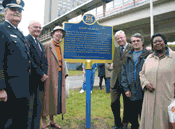
|

"...It was a gigantic flood with smashed houses and uprooted trees bobbing like corks, everything going down the river so fast. Houses crashing into the sides of other houses,
people everywhere screaming. And then you couldn't even hear the screams anymore."
� Volunteer fireman Bryan Mitchell (Toronto Star, October 14, 1984)
|
|
| Explore the story of Hurricane Hazel in this new, mobile-friendly story map. |
|
On October 15, 1954, the most famous hurricane in Canadian history struck Southern Ontario. Hurricane Hazel was projected to dissipate, but instead re-intensified unexpectedly and rapidly, pounding the Toronto region
with winds that reached 110 kilometres per hour (68 mph) and 285 millimetres (11.23 inches) of rain in 48 hours. Bridges and streets were washed out, homes and trailers were washed into Lake Ontario. Thousands were
left homeless, and 81 people were killed�more than 30 on one street alone. The total cost of the destruction in Canada was estimated at $100 million (about $1 billion today). This storm would change the Toronto landscape
forever and mobilize the need for managing watersheds on a regional basis. More�
300 million:
|
number of tons of water that fell during the storm
|
155:
|
Hazel's maximum speed (mph) in the Caribbean
|
81:
|
Number of people in Ontario who lost their lives from the flooding
|
4,000:
|
Number of families left homeless in Southern Ontario from the flood (1,868 in Toronto)
|
|
32:
|
Houses on Raymore Drive that were washed away by floods
|
4:
|
Magnitude of Hazel at the maximum rating prior to landfall on the Saffir-Simpson Hurricane scale
|
|
|

|

|

|
 Hazel's Legacy
Hazel's Legacy
A must-see documentary featuring first-hand accounts that have never been publicly recorded before and interviews with experts in the area of flood control. Click here to preview film: Broadband : Dialup
More...

The commemoration of the 50th anniversary of Hurricane Hazel brought many people out to one of the most devastated sites, Kings Mill Park, where the Ontario Heritage Foundation unveiled a bronze plaque in recognition of the 81 people that lost their lives
during the devastation.
 Click to view more photos
Click to view more photos
|

|
Paths to The Living City:
The Story of the Toronto and Region Conservation Authority
"The Living City project is a remarkable initiative, which should have a significant impact on the quality of life in the GTA in the 21st century. Paths to The Living City is an
indispensable companion for understanding the project's fundamental premises and historical roots.
Rich in detail, exciting in scope, Bill's careful story-telling will
lift the human spirit. Don't miss it!"
�The Honourable David E. Crombie, President and CEO, Canadian Urban Institute
|
|
|

|









|































